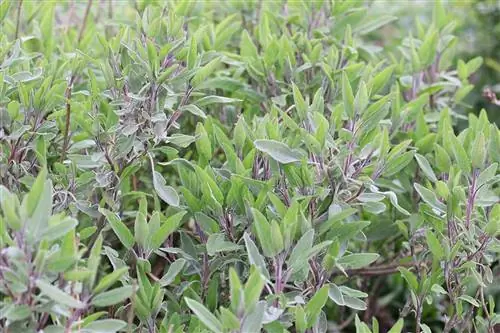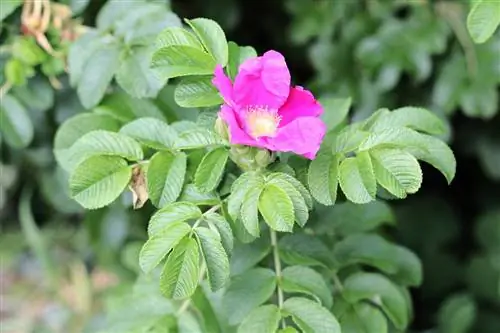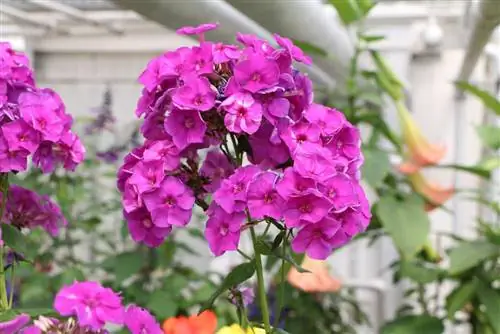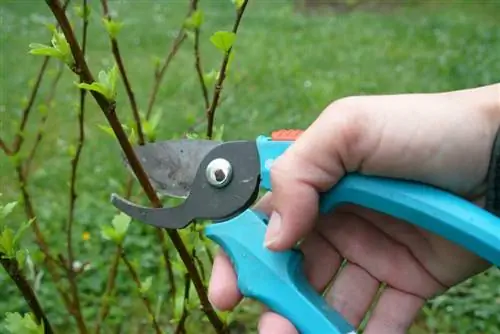- Author admin [email protected].
- Public 2023-12-17 03:39.
- Last modified 2025-01-24 12:45.
There are annual and perennial varieties of ornamental sage, as well as different colors ranging from white and pink to various shades of blue and the deepest purple.
General information about ornamental sage
The ornamental sage, like the spice sage, belongs to the mint family. The botanical name for all is “Salvia” with the corresponding variety name. When it comes to ornamental sage, you can find simple, robust varieties that are mostly perennial, while the exotic beauties usually only bloom for one year. The plants grow richly branched, somewhat bushy and can reach a height of up to 100 cm. While the taller types of ornamental sage fit ideally into herbaceous beds, the lower ones are suitable for rock gardens or as border plants on flower beds. Several long flower spikes grow from the slightly silvery foliage, most of which are found in a wide variety of shades of blue.
Depending on the variety, there are also other flower colors, such as white, dark and light red, pink to bright deep purple. Ornamental sage can be easily combined with other flowering plants such as phlox, coneflowers, white daisies, roses and also with grasses. All types of sage bloom twice. To do this, the wilted inflorescences must be cut off after the first flowering in order to stimulate a further burst of flowers. The first blooms appear from May to June/July, the second in September.
Overwintering ornamental sage
The ornamental sage can overwinter outdoors without any problems. To do this, it should be cut back far in late autumn. Some varieties are not quite as resistant to cold. These are mostly the species that have colorful leaves. Nevertheless, they can stay outside. They are protected with dry leaves or reed mats. Ornamental sage in pots or planters can simply be covered for the winter or placed in a frost-free place in the house. It is often enough to select a protected place. So it can survive the winter well even under the carport.
Location and soil requirements of ornamental sage
As a child of the south, the ornamental sage loves a place in the blazing sun, protected from winds. The soil should be well-drained and richly supplied with nutrients. Most species tolerate dry soil, but care should be taken to ensure adequate water supply during the flowering period. For some time now, ornamental sage has also been increasingly found in gravel beds and steppe plantings. Ornamental sage is also very suitable for plant pots, which later find a place in the house if varieties are not completely hardy.
Occurrence and types of ornamental sage
The original homeland of sage is the warm southern countries. Today, however, it is represented almost all over the world with its many species. Many of them are considered aromatic and medicinal plants. But there are now countless varieties of ornamental sage in beautiful colors.
- Salvia nemorosa “Blue Hill”, pure blue, height 40 cm
- Salvia nemorosa “Amethyst”, pink labial flowers, purple-violet stems, height 40 cm
- Salvia nemorosa “Caradonna”, dark purple, height 60 cm
- Salvia nemorosa “Snow King”, white, height 60 cm
- Salvia nemorosa “Porcelain”, white with sky blue flower center, bushy, height 40 cm
- Salvia microphylla “Hot Lips”, white with red colored lip, height up to 100 cm
- Salvia greggli “Royal Bumble”, deep red, height up to 60 cm
Almost all types of ornamental sage attract bees, bumblebees and butterflies, especially the “Blue Hill” variety.
Planting and propagation
Early spring is the ideal planting time for ornamental sage. It can fill gaps in the perennial bed or be specifically combined with other perennials. Group planting is also very effective. The planting distance depends on whether the sage grows bushy or more tall. Here you should follow the instructions on the label. To plant, you dig a correspondingly large hole for each perennial in which the soil is mixed with compost. Then insert the decorative sage, fill it with soil and press it down well. To ensure that the plant receives sufficient nutrients, it receives a fertilizer that is lightly incorporated into the soil. Finally, everything is poured heavily.
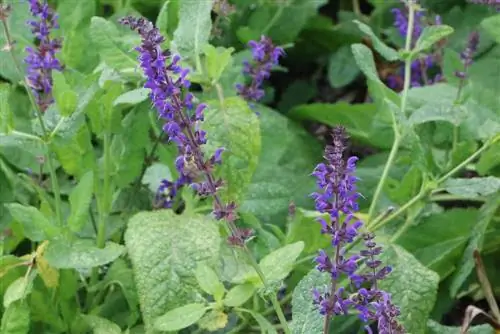
Propagation can be done by sowing or cuttings. Propagating cuttings is particularly worthwhile for beautiful annual varieties. The seeds are sown in February/March in flower pots that are placed in a warm room or in the greenhouse. As soon as 1-2 pairs of leaves appear, the plants are transplanted individually into pots. Depending on the weather and size, they can then be planted out in April/May. To propagate by cuttings, cut off one or more non-woody shoots in the summer, about 15 cm long. The lower leaves are removed, the shoot is placed in a flower pot with potting soil and then placed in a warm, protected place. Don't forget to water! By autumn, roots will have formed and the ornamental sage can be planted out. If it is not a hardy variety, leave the plant indoors over the winter.
Overwintering, cutting and fertilizing
Perennial, non-hardy ornamental sage varieties must be protected against frost in cold regions with leaves, reed mats or other means or overwintered indoors. But even for the winter-hardy species, light protection with brushwood is recommended. The main pruning of the perennial ornamental sage species takes place in early spring. With this maintenance pruning, the perennial is cut back vigorously and into shape, only then will it grow beautifully compact again. It is not advisable to prune in autumn as frost damage can occur. A slight pruning in the summer, both for annual and perennial perennials, reduces growth if the plant becomes too large. Cutting back into the old wood should be avoided, as the ornamental sage has difficulty recovering from this.
As fertilization, the overwintered ornamental sage receives a dose of perennial fertilizer or good natural fertilizer in March/April. After the first flowering and the dead shoots have been removed, further fertilizer is applied.
What you should know about sage in brief
- Ornamental sage is a popular and representative plant for the perennial border.
- There are annual and perennial species.
- Ornamental sage is available in various beautiful colors.
- It prefers a sunny, wind-protected spot.
- If the spent flower panicles are cut back, a second flowering will occur in late summer.
- Diseases and pests are not known for ornamental sage.
As the name suggests, ornamental sage is primarily used as a decorative plant. It is often combined with other plants in the bed. With roses, for example, you can create beautiful color effects by adding decorative sage.
Ornamental sage has purple or blue flowers that look great with subtle rose petals in white or pink. Depending on the type of sage, other flower colors may also occur. There are even fiery red flowers. The ornamental sage is therefore predestined as a companion plant. Rock garden lovers have long known about the beauty of ornamental sage. It is planted in large quantities in the rock garden. The ornamental sage blooms continuously from May/June to September/October and forms a dense carpet of flowers. However, in order for it to develop its full flower splendor, the optimal location must be chosen.
The Salvia genus has its origins in warm countries and can be found on almost every continent. The plant family itself includes more than 900 species. Most representatives have made a good name for themselves as seasoning and medicinal plants. The decorative sage only serves to flatter our eyes.


